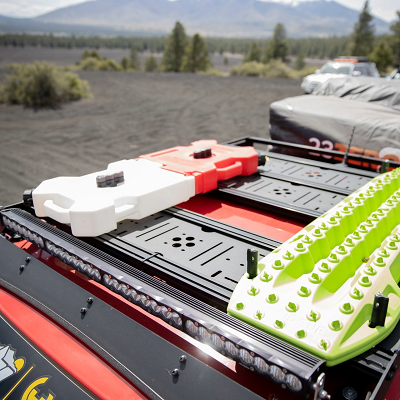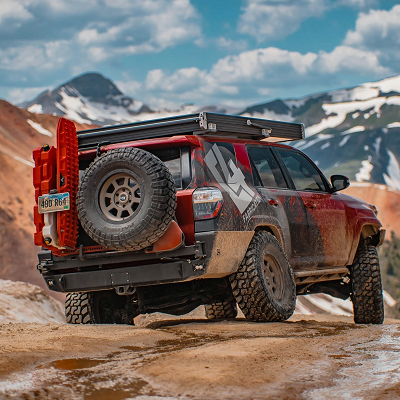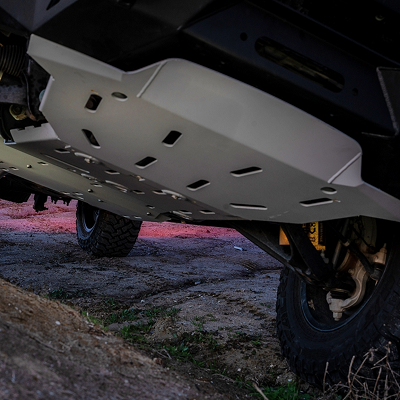Your Cart is Empty

Shop By Vehicle:

Roof Racks
Bed Racks

Front Bumpers

Rear Bumpers

Rock Sliders

Skid Plates
April 06, 2025 8 min read
When it comes to upgrading your Toyota Tacoma's suspension, shocks are arguably the most critical component and a top Tacoma accessory – yet they're often overlooked in favor of lift kits and fancy wheels. The right shock absorbers can transform your truck's handling, off-road capability, and overall ride quality.

We’ve tested dozens of shock configurations on Toyota Tacomas over the years, from bone-stock setups to race-ready full bypass systems. What I've learned is that shock selection isn't just about buying the most expensive option – it's about matching the shock to your specific driving style, terrain, and vehicle setup. This guide will help you through that process so you can get the perfect shocks for your Tacoma.
Despite common misconceptions, shocks don't support your truck's weight – that's the job of your springs. Instead, shocks control how those springs move.
Without shocks, your springs would bounce freely after hitting a bump, creating an unstable ride. Shock absorbers dampen this movement through hydraulic resistance, converting kinetic energy into heat as oil flows through valves inside the shock body.

Quality shocks provide three essential benefits:
Be honest about how you actually use your Toyota Tacoma, are you a…
Daily driver/commuter: If your Tacoma spends most time on pavement, prioritize shocks that deliver comfortable on-road manners with occasional off-road capability.
Weekend warrior: For those who commute during the week but hit trails on weekends, look for balanced shocks that perform well in both environments.
Serious off-roader: If your Tacoma sees frequent challenging terrain at speed, premium shocks with external reservoirs will provide meaningful benefits worth their higher cost. Additionally, consider high-performance coilovers to enhance off-road capability, improve ride comfort, and adjust handling performance under various driving conditions.
Overlander/expedition build: For those carrying heavy loads over long distances, look for shocks specifically designed for load-carrying with progressive valving.
Your shock selection needs to work with your overall suspension:
Stock height: Factory-replacement shocks should maintain Toyota's engineered ride characteristics while improving performance.
Leveled (1-2"): This modest height increase requires slightly longer shocks with valving calibrated for the altered geometry.
Lifted (2-6"+): As lift height increases, shock length, mounting points, and valving requirements change significantly.
Your shock travel should match your suspension travel – too short and they'll limit articulation, too long and they may allow excessive movement.
Consider what you typically carry:
Light loads: Standard valving works fine for stock or lightly modified trucks.
Moderate loads: If you regularly carry camping gear or moderate cargo, look for shocks with slightly firmer compression valving.
Heavy loads: For consistently heavy cargo, winches, steel bumpers, or roof top tents, specialized heavy-duty shocks will maintain control.
Variable loads: If your load varies significantly, adjustable shocks allow you to tune damping based on current conditions.
Quality shock absorbers range dramatically in price:
Entry-level ($80-150 per shock): Basic upgrades over stock.
Mid-range ($150-350 per shock): Significant performance improvements with better engineering and materials.
Premium ($350-1,200+ per shock): Professional-grade performance with features like external reservoirs and adjustability.
Remember that installation costs can add another $300-800 depending on complexity, and shocks typically need to be replaced or rebuilt every 30,000-60,000 miles.
Monotube shocks feature a single tube containing both oil and pressurized gas (typically nitrogen), separated by a floating piston. This design provides better heat dissipation than twin-tube alternatives, which is crucial during extended off-road sessions where heat buildup can cause performance to fade.

The simplified internal design allows for more responsive damping and more consistent performance when pushed hard. Most quality monotube shocks are also rebuildable, extending their service life and allowing for periodic maintenance rather than complete replacement. Brands like Bilstein, Fox, and King offer excellent monotube options that work well for Tacomas that see a mix of daily driving and weekend adventures.
Twin-tube shocks utilize two nested tubes where the inner tube contains the piston and valve assembly while the outer tube serves as a reservoir for oil and gas. This more traditional design typically comes at a lower price point, making these shocks popular for budget-conscious builds. They often deliver a smoother on-road ride than some monotubes, and their design protects the internal components from external damage better than exposed monotube shocks.

However, they're generally less efficient at dissipating heat, which can lead to performance degradation during extended off-road use. Twin-tube shocks are best suited for Tacomas that spend most of their time on pavement with only occasional light off-roading.
Remote reservoir shocks take the monotube concept a step further by adding an external reservoir connected by a hose. This additional chamber dramatically increases oil volume and provides superior heat dissipation, making these shocks the gold standard for serious off-road use. The additional oil capacity prevents performance fade even during extended high-speed off-road sessions in hot conditions.

Many remote reservoir shocks also include advanced features like adjustable compression and rebound damping, allowing you to fine-tune performance based on terrain. The trade-off comes in higher cost, more complex installation, and the need to find mounting locations for the reservoirs. For Tacoma owners who regularly tackle challenging trails at speed, the performance benefits make remote reservoir shocks a worthwhile investment.
Adjustable shocks allow you to modify compression and/or rebound damping, either through external knobs or clicks on the shock body or reservoir. This tunability is invaluable for Toyota Tacomas that see widely varying conditions or carrying requirements. You can run softer settings for everyday commuting, then stiffen things up for a weekend off-road trip with a fully loaded truck.

The ability to fine-tune your suspension makes these shocks incredibly versatile, though they do come with a higher price tag and slightly more maintenance requirements. Adjustable shocks make the most sense for serious enthusiasts who understand suspension dynamics and want to optimize performance across different driving scenarios.
Shock length must correspond to your suspension travel and lift height:
Stock height: Direct OEM replacement length.
Leveling kit (1-2"): Slightly longer than stock shocks.
Moderate lift (2-3"): Requires specific longer shocks for this range.
Significant lift (4-6"+): Need substantially longer shocks with mounting points and valving designed for altered geometry.
Using shocks that are too short limits suspension travel. Shocks that are too long may allow excessive travel that can damage other components.
Bilstein delivers excellent performance at reasonable price points. Their monotube design and precision valving offer significant improvements over stock shocks without breaking the bank.
The Bilstein 5100 series is particularly popular for lifted Tacomas, offering height-adjustable front struts that can provide up to 2.5" of lift while delivering better control than stock replacements.
For Tacomas serving as daily drivers with weekend adventure duty, Bilsteins hit the sweet spot of performance and value.
Fox brings their racing heritage to the Tacoma with the ultimate high-performance shocks that excel in demanding off-road environments. Their 2.0 Performance Series offers a significant step up from entry-level options, while their 2.5 Factory Series with remote reservoirs delivers race-worthy performance.

What sets Fox apart is their sophisticated Internal Bypass technology and optional DSC (Dual Speed Compression) adjusters that allow fine-tuning of both high and low-speed compression.

Fox shocks aren’t cheap, but their rebuildable design and exceptional performance in extreme conditions make them worth considering for serious off-roaders.
King shocks represent the pinnacle of off-road shock technology. Their exceptional build quality, precisely machined components, and sophisticated valving create shocks that can handle the most punishing conditions.
For Tacoma owners, King offers everything from direct OEM replacements to elaborate bypass systems. Their 2.5" OEM Performance Series provides an excellent balance of on-road civility and off-road capability.

The price is high, but Kings are truly rebuildable lifetime shocks that can evolve with your build.
ARB's Old Man Emu shocks are specifically designed with overlanding and expedition use in mind. Their Nitrocharger Sport shocks feature valving calibrated for vehicles carrying additional weight from bumpers, winches, and camping gear.
What makes OME unique is their system approach – they design their shocks to work specifically with their springs as a complete package.
For Toyota Tacoma owners building expedition rigs or regularly carrying heavy loads, OME provides excellent value with performance specifically engineered for these use cases.

ICON has carved out a strong position with shocks that deliver premium performance at slightly more accessible price points. Their Vehicle Dynamics technology focuses on creating application-specific tuning.
The ICON 2.0 Aluminum Series provides excellent all-around performance, while their 2.5 Series with CDC valve technology offers adjustability for fine-tuning.
ICON's defining feature is striking a balance between off-road capability and on-road comfort, making them ideal for dual-purpose Toyota Tacomas.
![]()
Choosing shocks based solely on price: The cheapest option is rarely the most cost-effective long-term.
Mismatching components: Pairing aggressive off-road shocks with soft springs creates handling problems.
Overlooking load requirements: Failing to account for the weight of accessories leads to poor performance.
Going too extreme: Ultra-stiff race shocks on a daily driver are problematic. Be honest about your actual usage patterns.
After years of testing different shock setups on Tacomas, my most important advice is this: buy shocks for the driving you actually do most often, not for the occasional extreme use or how you want your truck to look.
If 90% of your miles are on pavement with occasional moderate trails, focus on shocks that deliver excellent on-road manners with adequate off-road capability. If you're regularly tackling challenging terrain at speed, premium shocks with reservoirs will provide meaningful benefits worth their higher cost.
Quality Toyota Tacoma shocks are one of the most impactful upgrades you can make to your Tacoma's performance and comfort. While they might not have the visual appeal of bigger tires or bumpers, they'll transform how your truck drives in every scenario.
When should you replace shocks on a Toyota Tacoma?
Tacoma shocks should typically be replaced every 50,000-100,000 miles, depending on your driving conditions. However, if you do frequent off-roading or carry heavy loads, you might need to replace them sooner – around 30,000-50,000 miles. Always replace shocks when you notice signs of poor performance rather than strictly adhering to mileage guidelines.
How much does it cost to replace shocks on a Toyota Tacoma?
For a complete shock replacement on a Tacoma, expect to pay $400-$600 for basic OEM-equivalent shocks, including labor. Mid-range performance shocks with installation will run $800-$1,500, while premium off-road shocks with reservoirs can cost $1,500-$3,000+ installed. DIY installation can save $300-$500 in labor costs if you have the proper tools and experience.
How long do stock Tacoma shocks last?
Stock Toyota Tacoma shocks typically last 60,000-100,000 miles under normal driving conditions. However, this can vary significantly based on driving habits, load, and terrain. Off-road use, heavy loads, and extreme temperatures will dramatically reduce shock lifespan. Many owners report that performance begins to degrade noticeably around 50,000 miles, especially if the truck sees any off-pavement use.
How do I know if my Tacoma shocks are bad?
Signs of worn shocks include excessive bouncing after bumps, nose-diving during braking, body lean in corners, bottoming out over bumps, and uneven tire wear. You might also notice fluid leaking from the shock body or visible damage to the shaft. A quick test: push down hard on each corner of your truck and release – if the truck continues to bounce more than once, your shocks are likely worn and need replacement.
Comments will be approved before showing up.
Sign up to get the latest on sales, new releases and more …